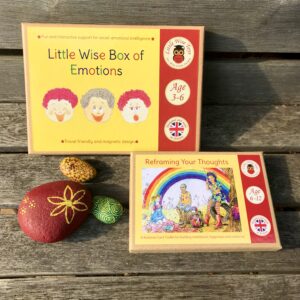
On World Mental Health Day I would like to talk about some things we can communicate with children about their emotions and feelings. I will touch on a small number of areas that are explored further in the Little Wise Box of Emotions for 3-6 year olds and the Reframing Your Thoughts toolkit for 6-12 year olds.
Validation
The activity sets highlight how validating children’s feelings by offering empathy can be powerful as feeling understood can help to calm big feelings and emotions (e.g. ‘I can understand why it feels disappointing’).
Seeing another perspective
As well as validating their feelings, we can ask helpful questions to encourage children to see another viewpoint. For example, rather than saying ‘You’ll do better next time’ or ‘It’s not a big deal’ (it probably is to them), we could say, ‘It can be disappointing when things don’t work out how you had hoped. What do you think you might be able to do differently next time?’.
All emotions and feelings are OK
As a further example, the activity sets also talk about the importance of letting children know that it is absolutely OK to experience all sorts of different emotions and feelings (including more challenging ones). They are not things that need to be suppressed. Actually, trying to do this can even help challenging feelings to grow and become more overwhelming. It is much better to learn to acknowledge big feelings and work with them to achieve a more helpful outcome.
How we react to our feelings is important
We can also let children know that it is how they react to their feelings that is important. For example, when children act out in a way that isn’t helpful or appropriate, instead of them feeling that they are somehow bad because of how they behaved, we can offer an empathetic and constructive approach, while also setting boundaries. For example, ‘I understand it can be frustrating when… But it’s not OK to… Let’s look for a better way to respond to this situation’.
Keep talking
And, of course, a key thing we can do is to open the door to conversations with children about their emotions and feelings and, in turn, help them to see that it is absolutely OK for them to talk about their emotions and feelings too.
I hope this small selection of highlights above offer some useful food for thought.







